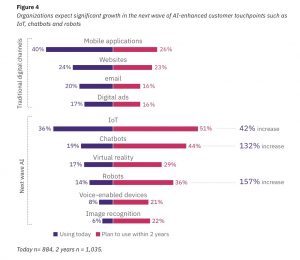In a “C Suite Study”* with a CMO focus, IBM research summarized expectations for artificial intelligence in the graphic below:

The words are nearly illegible. The caption reads: “Organizations expect significant growth in the next wave of AI-enhanced customer touchpoints such as IoT, chatbots and robots”. Those touchpoints are defined as follows: :
- Traditional digital channels: Mobile applications, Websites, email and digital ads
- Next Wave AI: IoT, Chatbots, Virtual reality, Robots, Voice-enabled devices, Image recognition
Mobile applications and IoT are categories that are most “in use” today (40% and 36%, respectively). On a percentage basis, IoT and chatbots show the greatest potential for growth in the coming 2 years.
To my surprise – primarily because Opus Research tracks the #VoiceFirst world so closely – only 8% of the respondents indicated that they already employ AI in conjunction with “voice-enabled devices”, calling into question which of the “Mobile applications” (40%) or IoT devices (36%) are not voice enabled.
From the perspective of the C-Suite, the view of AI-infused world is even more tone deaf. With only an additional 21% planning to augment voice-enabled devices with AI, they will lag behind Chatbots, Robots (not sure what that word means in this context) and Virtual reality, and be neck-and-neck with “Image recognition”. This has to come as a shock to all the project managers employed by marketing and IT to add Alexa Skills or Google Actions to their customer touchpoints. And for retailers, consumer packaged goods providers, financial services companies and other service providers with marketing plans that embrace services to smart TV’s and other devices like the Echo Show that elegantly bring together voice, video, image and text.
Timing is Everything and AI is Everywhere
My suspicion is that the survey took place at a point when the proliferation of smart speakers and their attendant voice assistants were not as pervasive as they are today. It’s easy to observe that traditional marketing channels, especially email and digital ads are on their way out, although 16% of CMOs still see room for improvement with the use of AI (presumably to improve targeting and relevance). But it is already observable that that the limited, decidedly one-way capabilities of “traditional” digital media are being supplanted by chatbots on Websites and in Mobile apps and voice-based agents on smart speakers. The categories just don’t match up with reality.
Respondents may have been thinking that “IoT” is the greatest common denominator, having read accounts that put the number of smart, networked devices in the world in the tens of billions in short order. Those large number are deceptive and, when looking for opportunities to bring AI into marketing workflows from early demand gen to transaction processing the greatest common denominator has to be “all-of-the-above.” Thus the focus of AI investment should be on centralized and device-based resources that foster Natural Language Understanding, Machine Learning and Conversation Management.
Marketing, in the age of AI, is proving to be end-to-end and all of touchpoints should offer consistent, conversational and accurate answers, actions or recommendations at scale, regardless of their point of origin. To support marketing objectives intelligently requires their mobile app, Website, Webchat, smart speaker, auto command center, robot and even email to be on par with one another and responsive to each individual.
*IBM C Suite Study, 19th edition CMO focus
Categories: Intelligent Assistants

 2025 Conversational AI Intelliview: Decision-Makers Guide to Self-Service & Enterprise Intelligent Assistants
2025 Conversational AI Intelliview: Decision-Makers Guide to Self-Service & Enterprise Intelligent Assistants  Talk to the Web: How NLWeb Opens Conversational Access to Site Content
Talk to the Web: How NLWeb Opens Conversational Access to Site Content  Battling ‘Botenfreude’: The Power of People and Policy
Battling ‘Botenfreude’: The Power of People and Policy  Voice AI Agents Redefine CX: Trends, ROI, and Strategies for 2025
Voice AI Agents Redefine CX: Trends, ROI, and Strategies for 2025